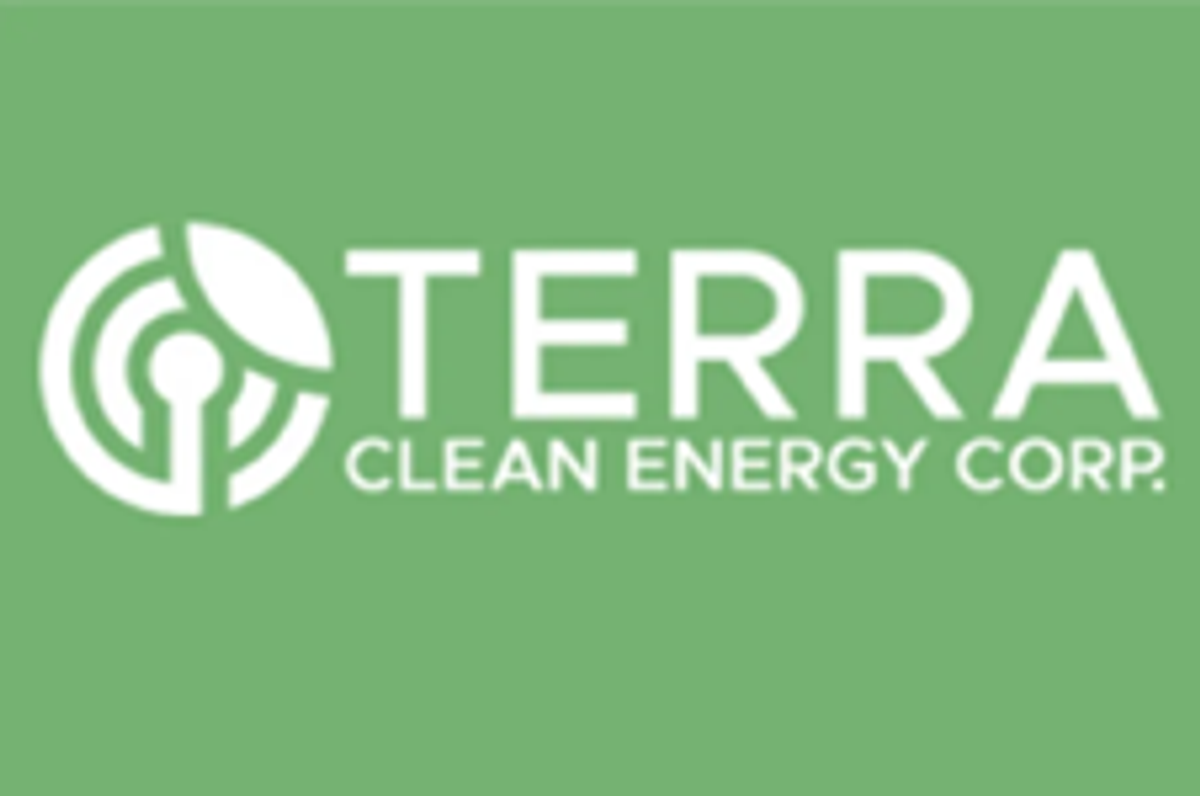
October 20, 2024
Toro to integrate vanadium into the Lake Maitland uranium resource, in preparation for scoping study update with re-optimised pit, with potential to increase mining volume and potential production
Toro Energy Limited (ASX: TOE) (‘the Company’ or ‘Toro’) is pleased to announce that it has initiated the work of integrating the new Lake Maitland vanadium resource estimation into the recently updated Lake Maitland uranium resource block model. This work is being undertaken in preparation for an updated scoping study, which is estimated to be completed before the end of the year.
- Integration of the recently re-estimated Lake Maitland vanadium resource into the Lake Maitland uranium resource block model has commenced (refer to ASX announcement of 24 September 2024 for resource estimation details).
- Vanadium resource integration is the start of preparations for a new scoping study update for a stand-alone uranium-vanadium mining and processing operation at Toro’s Lake Maitland Deposit.
- New scoping study update will include a re-optimisation of the proposed Lake Maitland mining pit using the new Lake Maitland resource estimation results to assess an increase in mining volume and therefore potential production.
- The new stand-alone Lake Maitland operation scoping study update is expected to be finalised before the end of the year.
- Future planned project optimisation work and the pilot plant programme will evaluate further economic improvements driven by Lake Maitland’s close proximity to Toro’s 100% owned Centipede-Millipede & Lake Way uranium deposits by potentially integrating additional resources from these two deposits.
- Strong improved financial outcomes from the recently updated Lake Maitland Scoping Study include:
- Pre-tax NPV8 of A$832.8M (+37% increase of A$223.20M)
- Excellent 48% IRR (+7% increase)
- Total EBITDA of $2,303.3M (+30% increase of A$534.4M)
- Total undiscounted cash flow of A$1,903.3M pre-tax – average >$2M per week (+36% increase of A$507.3M)
- Short payback period of 2.1 years
- Low C1 operating cost of US$17.28/lb U3O8 in years 1 to 7 when high grade uranium resource is being processed
- Strong life of mine C1 operating cost of only US$24.78/lb U3O8
- Low AISC cost of US$22.58/lb U3O8 in years 1 to 7 when high grade uranium resource is being processed
- Strong life of mine AISC cost of only US$30.55/lb U3O8
- Modest total CAPEX of US$149M plus 20% for contingency and 15% for EPCM over a 17.5 year mine life producing a total of 22.8Mlbs U3O8 and 11.9 Mlbs V2O5.
Management Commentary
Commenting on this development, Toro’s Executive Chairman, Richard Homsany, said:
“Toro continues to advance the Wiluna Uranium Project through several optimisation and technical workstreams. The inclusion of the updated vanadium resource into the existing Lake Maitland resource is a key update ahead of reporting our new scoping study for the project later this year.
Importantly, the new scoping study will include a pit re-optimisation of the recently updated uranium resource block model, with the vanadium resource integrated within it, to assess a change to mining volume and therefore potential production. A favourable outcome on this alone could significantly increase the value of the Wiluna Uranium Project. This will more accurately represent the potential mining volumes, production figures and economic/financial outcomes for the proposed stand-alone Lake Maitland mining and processing operation.
Adding further weight to the global uranium conversation, global companies including Microsoft, Google and Amazon have recently committed to source nuclear energy to power their AI and data centres whilst expressly recognising that nuclear energy has a track record of providing a reliable source of safe carbon-free energy globally.
Against this backdrop and driven by the global push towards ‘net zero’, it is becoming increasingly clear that any regulatory or policy stance against exporting uranium to countries that need nuclear energy to grow their economies and support their de-carbonisation agendas, requires immediate re-evaluation.
As we head towards a busy and important phase for the business, the Board is confident that Toro has the necessary funding to deliver on several key, near term milestones that we believe will unlock further value for shareholders.”
Click here for the full ASX Release
This article includes content from Toro Energy, licensed for the purpose of publishing on Investing News Australia. This article does not constitute financial product advice. It is your responsibility to perform proper due diligence before acting upon any information provided here. Please refer to our full disclaimer here.
TOE:AU

Sign up to get your FREE
Toro Energy Investor Kit
and hear about exciting investment opportunities.
- Corporate info
- Insights
- Growth strategies
- Upcoming projects
GET YOUR FREE INVESTOR KIT
The Conversation (0)
14 April
Toro Energy
Investor Insight
Toro Energy’s significant uranium resource in a tier 1 jurisdiction places the company in a compelling position to leverage a bullish uranium market and the mineral’s strategic role in global decarbonization.
Overview
Australia is the world’s third-largest uranium producer (12 percent) next to Kazakhstan (43 percent) and Canada (13 percent). It is home to the Wiluna Uranium Project, the flagship asset of Toro Energy (ASX:TOE), a uranium exploration and development company also exploring value in other commodities.
The 100-percent-owned Wiluna uranium project includes three key deposits – Lake Maitland, Centipede-Millipede and Lake Way – and offers significant uranium exposure of 87.8 million tons (Mt) at 381 ppm for 73.6 Mlbs U3O8 at 100 ppm cut-off (JORC 2012). It is located only 30 kilometers southeast of Wiluna in Central Western Australia.
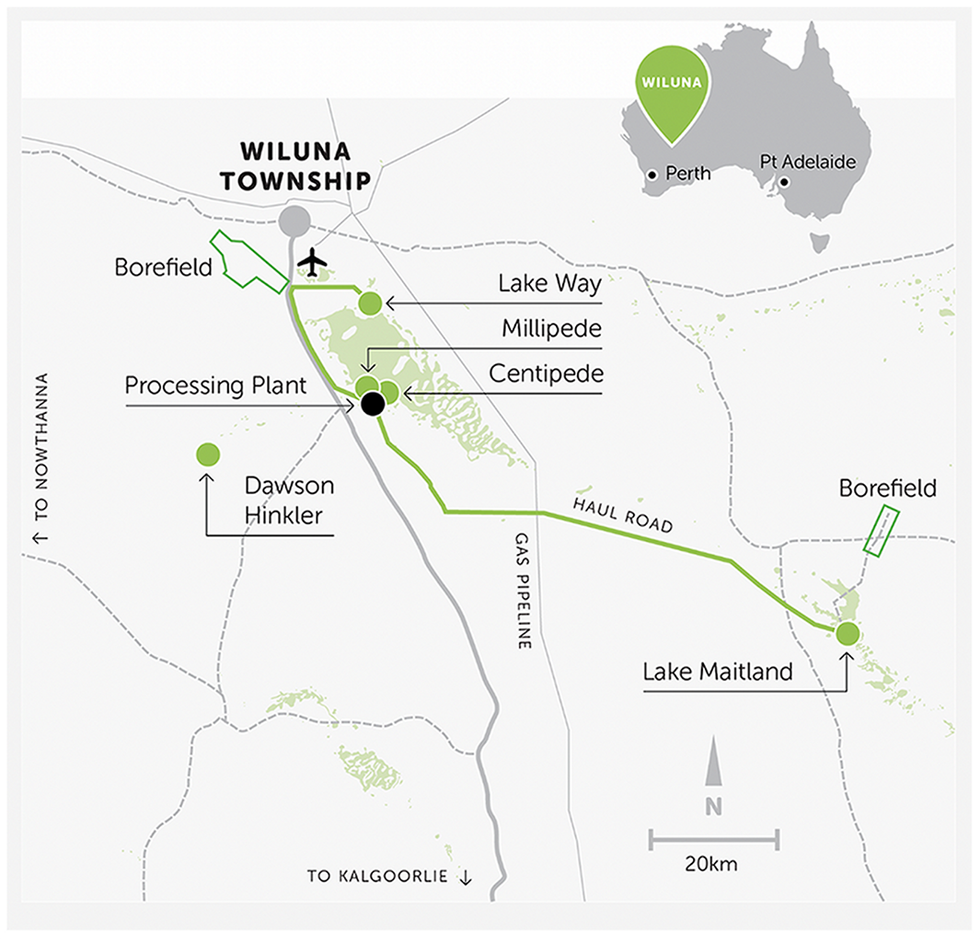
The Wiluna uranium project has received state and federal approval (subject to required amendments) and has been granted mining leases.
Considerable research over recent years has identified processing redesign opportunities from unique geological attributes within the uranium deposits, but particularly at Lake Maitland, as well as the ability to extract the inherent vanadium held within the uranium ‘ore’ for a vanadium by-product.
Within the uranium mineralization envelope, the Wiluna project is estimated to contain 141.8 Mt vanadium oxide (V2O5) at 286 ppm for 89.3 Mlbs of V2O5 at 100 ppm V2O5 cut-off (JORC 2012), as of September 24, 2024.

The scoping study for the stand-alone Lake Maitland uranium-vanadium operation option shows potential for exceptional financial returns with a pre-tax NPV of AU$832.8 million, a short payback period of 2.5 years, 48 percent internal rate of return, and low capex of AU$291 million (US$203 million), based on price assumption of US$85/lb U3O8, US$5.67/lb V2O5 and a 70 cents US$:AU$ exchange rate.
In September 2024, the Lake Maitland deposit has been re-estimated using a resource envelope more in line with the other Wiluna uranium deposits; allowed the lowering of the cut-off grade to 100ppm U3O8, expanding Lake Maitland resources by 12 percent and that of the entire Wiluna project by 17 percent (when the expansions at Lake Way and Centipede-Millipede are also included).
The design phase of Toro Energy’s beneficiation and hydrometallurgical pilot plant is on track and in line with plans to finalise construction. The pilot plant will test the improved beneficiation and hydrometallurgical circuit developed by Toro from bench scale research at a closer-to-production scale and as single streams. It will also test potential ore from the three uranium-vanadium deposits that Toro believes will make up an extended Lake Maitland operation – these include Lake Maitland, Lake Way and Centipede-Millipede.
The Lake Maitland deposit is part of a joint venture partnership with two reputable Japanese corporations, Japan Australia Uranium Resource Development. (JAURD) and Itochu.
Toro has been actively evaluating the prospectivity of its Wiluna asset portfolio for minerals other than uranium, including nickel and gold.
The Lake Maitland mining pit re-optimization which incorporated the latest resource estimates and updated financial data has been completed. Mine scheduling is currently underway in preparation for the upcoming scoping study update.
Toro’s Dusty nickel project is located on the northern, eastern and southern shores of Lake Maitland and the Lake Maitland uranium deposit and is focused on two main target areas: Dusty and Yandal One. These properties will be the subject of a proposed demerger, following Toro’s recent strategic review of its non-core assets and future plans to solely focus on its uranium development opportunities and its flagship Wiluna project.
Toro Energy’s management team and board of directors have extensive experience in the mining industry, with combined expertise that includes working at major mining houses, exploration companies, uranium mining operations, corporate financing and government and community relations.
Company Highlights
- Toro Energy is a well-established uranium exploration and development company based in Western Australia, with a strong focus on unlocking value from additional commodities within its highly prospective landholdings.
- The company holds JORC-compliant uranium resources totaling 112.7 million pounds (Mlbs) of uranium oxide (U₃O₈) across its Western Australian projects.
- Toro’s 100%-owned flagship Wiluna Uranium Project, located 30 km southeast of Wiluna in Central Western Australia, hosts a total resource of 87.8 million tonnes (Mt) at 331 ppm for 73.6 Mlbs U₃O₈ at a 100 ppm cut-off. The project encompasses three key deposits: Lake Maitland, Centipede-Millipede, and Lake Way.
- Within the uranium mineralization envelope, Toro has also defined a maiden vanadium resource of 89.3 Mlbs V₂O₅ at a 100 ppm cut-off. A scoping study for a stand-alone Lake Maitland uranium-vanadium operation indicates the potential for exceptional financial returns.
- Beyond uranium, strategic exploration within the Lake Maitland tenure has led to the discovery of massive nickel sulphide and vein-hosted gold deposits, including the Dusty Nickel Project and the Yandal Gold Project.
- Following a recent strategic review, Toro is evaluating a renewed focus on uranium development and is considering the demerger of non-core assets, including its nickel, gold, and base metal projects in Western Australia.
- Toro is led by a highly experienced management team and board of directors, with deep expertise in uranium exploration, mining, and base metal exploration.
Key Projects
Wiluna Uranium Project
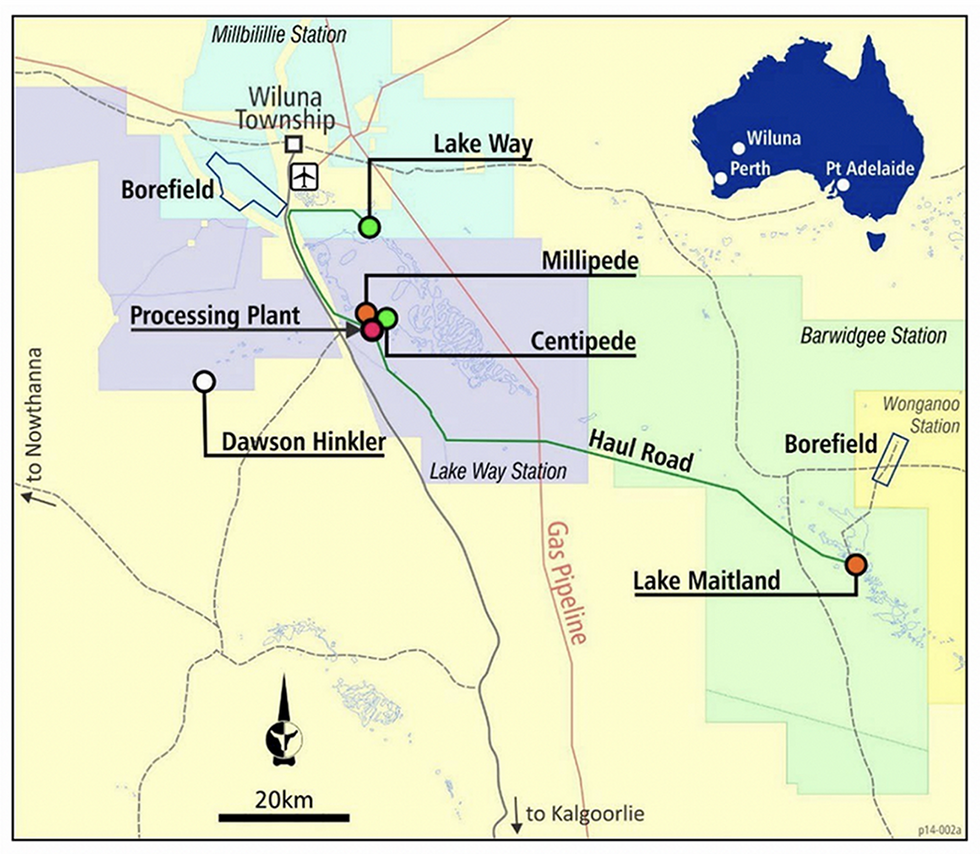
Location of the Lake Maitland Uranium and Vanadium Deposit within Toro’s portfolio of Uranium-Vanadium Deposits that make up the company’s Wiluna Uranium-Vanadium Project
Toro Energy’s flagship asset is located only 30 kilometers from the town of Wiluna in the northern goldfields region within central Western Australia. The Wiluna project contains 87.8 Mt at 381 ppm for 73.6 Mlbs U 3O8 at 100 ppm cut-off over three deposits: Centipede-Millipede, Lake Way and Lake Maitland. The asset has been de-risked and optimized to improve yield and has successfully incorporated the processing of a vanadium resource as a by-product. A scoping study was completed for a stand-alone Lake Maitland uranium-vanadium operation.
Project Highlights:
- De-risked Uranium Project: Toro Energy has de-risked the Wiluna uranium asset by securing state and federal approvals, mining leases, and a simplified mining process. Further approvals are needed due to project enhancements. Extensive lab testing has also validated an efficient beneficiation and processing technique, enabling vanadium extraction as a valuable by-product.
- Uranium Exploration assets: Toro also owns 100 percent of three other exploration projects in Western Australia that have a total uranium resource of 39.1 Mlbs Nowthanna (200ppm U3O8 cut-off), Dawson Hinkler (100ppm U3O8 cut-off) and Theseus (200ppm U3O8 cut-off).
- Lake Maitland Pit Expansion: A 2022 pit expansion for a stand-alone Lake Maitland mining and processing operation, based on an updated uranium price, the inclusion of vanadium as a by-product, revised OPEX based on a the new beneficiation and processing flow sheet, increased the potential volume of uranium ore
- Initial Scoping study at proposed Lake Maitland Uranium-Vanadium Operation: Initial scoping study results following the 2022 pit expansion highlight the project’s potential for robust financial returns, increasing the asset to US$608 million in potential gross product value (assumes a US$70/lb U3O8, US$5.67/lb V2O5 price and a US$: AU$0.70 exchange rate).
- 2024 Scoping Study Financial Metrics Update: A refresh of the scoping study on the stand-alone Lake Maitland operation which incorporates current financial metrics and improved uranium pricing has been recently completed resulting an increase in pre-tax NPV to $832.8 million and 48 percent IRR (assumes a US$85/lb U3O8, US$5.67/lb V2O5 price and a US$: AU$0.70 exchange rate).
- Expanded Resource: Reducing the U₃O₈ and V₂O₅ cut-off grade to 100 ppm has significantly expanded resources across all three uranium-vanadium deposits:
- Lake Maitland:
- U₃O₈: +12 percent (3.2 Mlbs) to 29.6 Mlbs, average grade 403 ppm
- V₂O₅: +74 percent (13.4 Mlbs) to 31.4 Mlbs, average grade 285 ppm
- Centipede-Millipede:
- U₃O₈: +25 percent (5.98 Mlbs) to 29.95 Mlbs, average grade 351 ppm
- V₂O₅: +17% (6.6 Mlbs) to 45.2 Mlbs, average grade 281 ppm
- Lake Way:
- U₃O₈: +15 percent (1.79 Mlbs) to 14.12 Mlbs, average grade 406 ppm
- V₂O₅: +9.5 percent (1.1 Mlbs) to 12.7 Mlbs, average grade 307 ppm
- Lake Maitland:
- Pilot Plant Design Commissioned: A detailed pilot plant design is being undertaken to further assess the new processing flowsheet for Lake Maitland at a closer to ‘operational’ scale. The pilot plant design is on track incorporating all aspects of both uranium and vanadium production. A sonic core drilling program will commence to deliver potential ore to the pilot plant currently in design for Wiluna.
- Robust Local Infrastructure: The assets are within an established mining center, which means much of the required infrastructure is readily available. The project has access to power and water, which reduces initial development costs.
- Joint Venture Partnership: Toro Energy has entered into a joint venture partnership with JAURD and Itochu for its Lake Maitland deposit. Both corporations have the right, but not the obligation, to earn a combined 35 percent interest in the project upon contributing US$39.6 million, and an additional proportionate share of expenditure thereafter, once a positive final investment decision has been made based on a definitive feasibility study.
The Dusty Nickel Project – Discoveries of Massive Nickel Sulphide
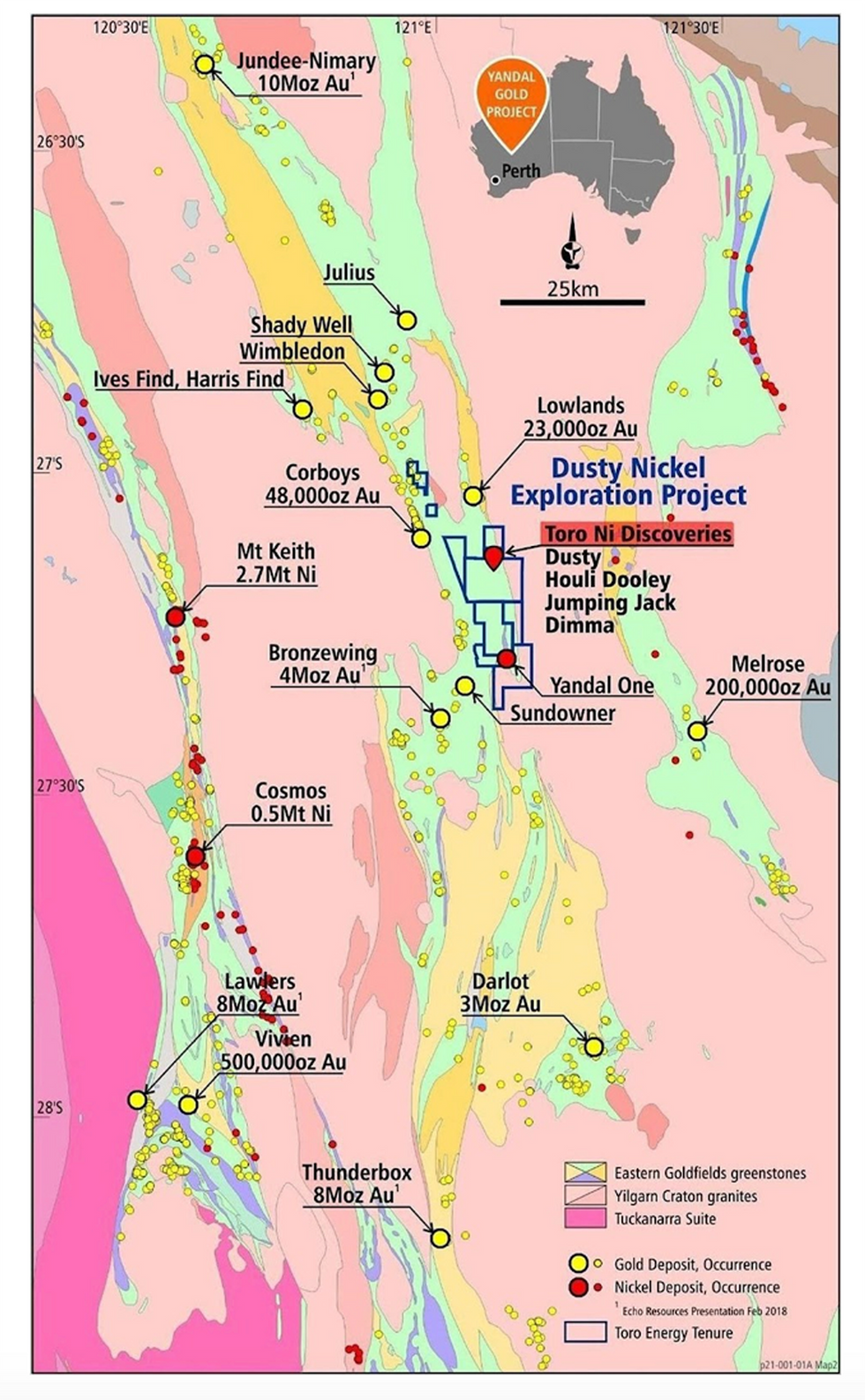
Toro’s Lake Maitland tenure is located in the Yandal Greenstone Belt within the Yilgarn Craton of Western Australia, a gold district within a world-class gold and nickel province. With little exploration for non-uranium minerals ever conducted on the properties, Toro considers the project area highly prospective for nickel, gold and base metals.
Exploration and diamond drilling have identified four massive/semi-massive nickel sulphide zones within just 4.5 km of a 7.5 km komatiite magnetic trend. Limited testing has been conducted across a 15 km strike of known komatiite-ultramafic target rock. With minimal drilling at Lake Maitland, the full extent of prospective nickel sulphide mineralization remains unknown.
Project Highlights:
- Four zones of massive nickel sulphide discovered: Toro has discovered four zones of massive and semi-massive nickel sulphides: Dusty, Houli Dooley, Jumping Jack and Dimma.
- Yandal OneTarget Area: The Yandal One Target Area is located some 17 kilometers south of the Dusty discoveries and with limited drilling, Toro has proven the existence of another komatiite with the potential to host massive nickel sulphide.
Toro Yandal Gold Project
The Lake Maitland tenure is located only 20 kilometers northeast of the world-class Bronzewing and Mt McClure gold mines within the same Greenstone Belt, the Yandal, within one of the most famous gold provinces in the world, the Yilgarn Craton.
Early exploration by Toro at the Golden Ways target area in the north of the project has uncovered surface rock chip samples of up to 70 g/t gold and significant drilling results, including:
- 5 meters at 4.4 g/t from 22 meters (TERC24)
- Including 2 meters at 9.93 g/t from 22 meters
- 4 meters at 3.3 g/t from 28 meters (TERC25)
- Including 1 meter at 10.9 g/t from 28 meters
- 2 meters at 3.79 g/t from 10 meters (TERC38)
- Including 1 meters at 7.33 g/t from 10 meters
- 3 meters at 1.41 g/t from 9 meters (TERC36)
- Including 1 meters at 2.76 g/t from 10 meters
Management Team
Richard Homsany - Executive Chairman
Richard Homsany has extensive experience in the resources industry, having been the executive vice-president for Australia of TSX-listed Mega Uranium since April 2010. He has worked for North Ltd, an ASX top 50-listed internationally diversified resources company in operations, risk management and corporate, before its takeover by Rio Tinto.
Homsany is an experienced corporate lawyer and certified practicing accountant (CPA) advising numerous clients in the energy and resources sector, including publicly listed companies. He was corporate partner at international law firm DLA Phillips Fox (now DLA Piper), where he advised clients on a range of transactions and matters including capital raising, IPOs, stock exchange listing, mergers and acquisitions, finance, joint ventures, divestments and governance.
Michel Marier - Non-executive Director
Michel Marier joined Sentient in 2009 as an investment manager. Before joining Sentient, Marier worked eight years in the private equity division of la Caisse de dépôt et placement du Québec. Marier holds a master’s degree in finance from HEC Montreal and is a CFA charter holder.
Richard Patricio - Non-executive Director
Richard Patricio is the CEO and president of Mega Uranium, a uranium-focused investment and development company with assets in Canada and Australia. Patricio has built a number of mining companies with global operations. He holds senior officer and director positions in several junior mining companies listed on the TSX, TSX Venture, AIM and NASDAQ exchanges. He is currently also a director of NexGen Energy (TSE:NXE, Mkt Cap. C$2.7 billion). He previously practiced law at a top-tier law firm in Toronto and worked as an in-house general counsel for a senior TSX-listed company. He received his law degree from Osgoode Hall and was called to the Ontario bar in 2000.
Dr. Greg Shirtliff – Geology Manager
Dr. Greg Shirtliff, with a PhD in mine-related geology and geochemistry from ANU, has 20+ years of experience across environmental, mine geology, resource development, exploration, and management. His career includes roles at ERA-Rio Tinto’s Ranger Uranium Mine, Cameco Australasia, and currently as Lead Geologist & Technical Manager at Toro Energy. He oversees uranium and mineral resource development, directs exploration strategy, supports EPA approvals, and guides engineering and metallurgical assessments.
Katherine Garvey - Legal Counsel and Company Secretary
Katherine Garvey is a corporate lawyer who has significant experience in the resources sector. Garvey advises public (both listed and unlisted) and proprietary companies on a variety of corporate and commercial matters including capital raising, finance, acquisitions and disposals, Corporations Act and ASX Listing Rule compliance, corporate governance and company secretarial issues. She has extensive experience drafting and negotiating various corporate and commercial agreements including farm-in agreements, joint ventures, shareholders’ agreements, and business and share sale and purchase agreements.
Marc Boudames - Financial Controller
Marc Boudames is experienced in statutory financial reporting, taxation, ERP systems, business analytics, corporate transactions, due diligence, mergers & acquisitions, finance, joint ventures and divestments. He previously worked at RSM Bird Cameron, as general manager –finance & administration for ASX-listed Redport Ltd and Mega Uranium (Australia), a Canadian TSX-listed mining and equity investment company focused on global uranium properties and multi-mineral exploration. He has worked for multiple companies across various industries, including listed and public companies associated with the mining and oil and gas sectors, such as WesTrac, CB&I and Spotless Group.
Keep reading...Show less
Uranium development and exploration in Western Australia
27 May
Updated Scoping Study Results Lake Maitland Uranium Project
30 April
Quarterly Activities and Cashflow Report March 2025
31 January
Quarterly Activities and Cashflow Report December 2024
3m
Terra Clean Energy: Advancing an Expansive Uranium Landholding in the Prolific Athabasca Basin
Terra Clean Energy (CSE:TCEC,OTCQB:TCEFF,FSE:C9O0) is advancing its 100 percent-owned South Falcon East Project, strategically located in the southeastern Athabasca Basin, Saskatchewan — one of the world’s premier uranium districts. The project stands out among uranium juniors for its shallow mineralization, strong discovery potential, and proximity to established infrastructure.
Anchored by a historical resource of nearly 7 million pounds (Mlbs) U₃O₈ at the Fraser Lakes Zone B, the project also hosts multiple zones of confirmed mineralization and structural alteration. Terra is advancing toward a NI 43-101-compliant resource update in 2025, with the goal of materially expanding its resource base. Situated along the highly prospective Way Lake Conductor — a folded, uranium-enriched corridor — the project offers significant upside for new discoveries beyond the existing resource.
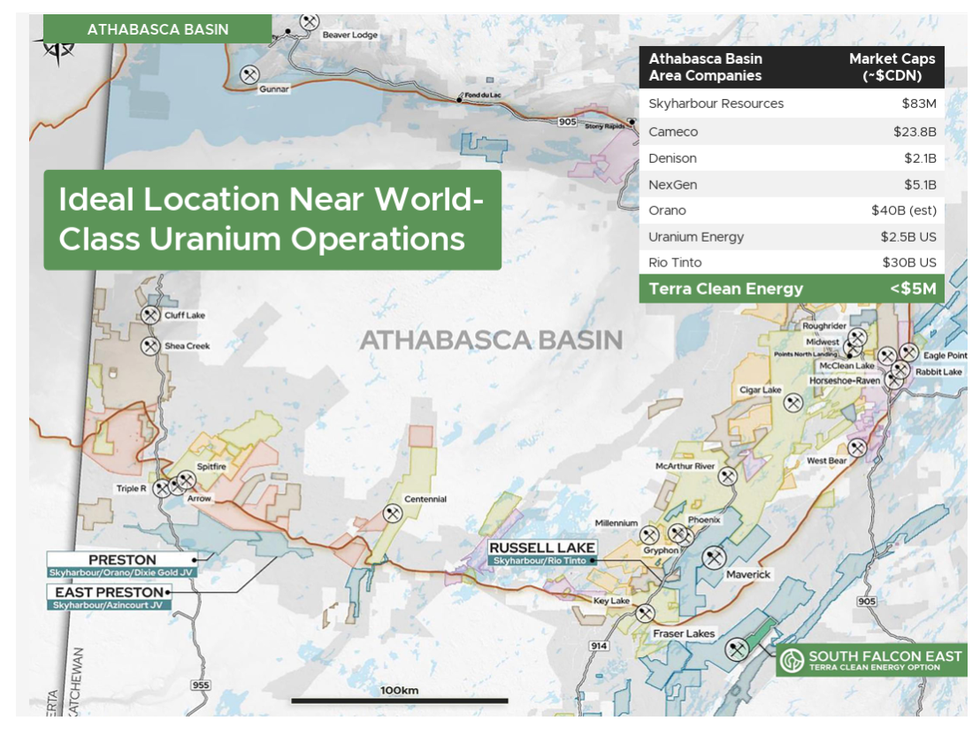
South Falcon East, Terra Clean Energy’s flagship project, spans 12,234 hectares on the southeastern margin of the Athabasca Basin, Saskatchewan, just 55 km east of the historic Key Lake uranium mill. The project hosts the Fraser Lakes Zone B deposit, with a historical inferred resource of 6.96 Mlbs U₃O₈ at 0.03% and 5.34 Mlbs ThO₂ at 0.023 percent, contained within 10.35 Mt using a 0.01 percent U₃O₈ cutoff. While not yet classified under NI 43-101, Terra considers the resource data reliable and a strong foundation for future exploration and growth.
Company Highlights
- Unique, Shallow Uranium System: Only micro-cap in the Athabasca Basin advancing a near-surface uranium deposit, with significantly reduced exploration and potential development costs.
- Pounds-in-the-ground Upside: Historical resource of 6.96 Mlbs U₃O₈ and 5.34 Mlbs ThO₂, with considerable expansion potential from historical and recent drilling.
- Prime Location: Situated 55 km east of the Key Lake Mill within the prolific Athabasca Basin – home to the world’s highest-grade uranium deposits.
- Strong Technical Leadership: Led by a team with extensive uranium exploration and capital markets experience, including veterans from Skyharbour Resources and Azincourt Energy.
- Resource Update Underway: 2024–25 infill and step-out drilling will support an NI 43-101 compliant mineral resource estimate, incorporating higher-grade intercepts from Terra’s 2024 campaign.
- Re-rating Potential: Market cap under $5 million despite having a historical uranium resource, confirmed mineralized zones, and near-term catalysts.
This Terra Clean Energy profile is part of a paid investor education campaign.*
Click here to connect with Terra Clean Energy (CSE:TCEC) to receive an Investor Presentation
Keep reading...Show less
1h
Terra Clean Energy
Investor Insight
With a clear, discovery-focused strategy, Terra Clean Energy is advancing one of the most unique near-surface uranium opportunities in the Athabasca Basin, targeting rapid resource growth and re-rating potential through continuous exploration, aggressive drilling, and disciplined capital deployment.
Overview
Terra Clean Energy (CSE:TCEC,OTCQB:TCEFF,FSE:C9O0) is unlocking value from its wholly owned South Falcon East project, located in the southeastern Athabasca Basin in Saskatchewan, Canada. The project uniquely positions Terra among uranium juniors due to its shallow mineralization and proximity to world-class infrastructure.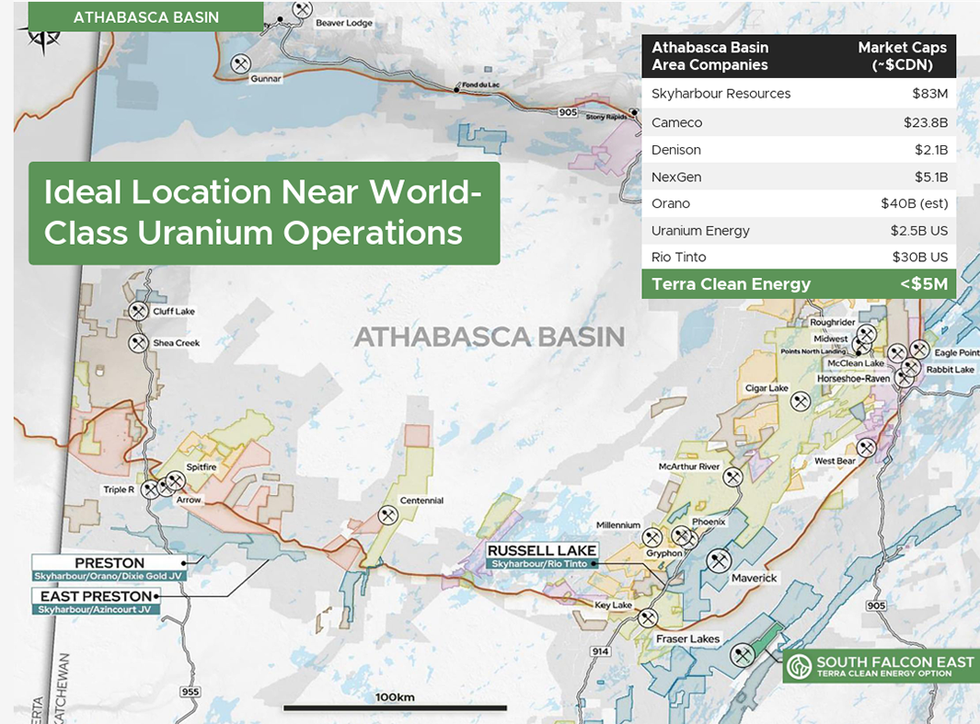
With a historical uranium resource of nearly 7 million lbs (Mlbs) U₃O₈ at Fraser Lakes Zone B, and multiple zones of confirmed mineralization and structural alteration, Terra is targeting an updated NI 43-101 resource in 2025, aiming to significantly grow its asset base. The project’s location along the Way Lake Conductor – a folded, fertile corridor – offers blue-sky potential for additional discoveries.
As global demand for uranium surges due to energy security concerns and the electrification boom (AI, EVs, nuclear baseload), Terra offers investors a rare combination of historical resource foundation, shallow mineralization, and transformational growth potential at a micro-cap valuation.
Company Highlights
- Unique, Shallow Uranium System: Only micro-cap in the Athabasca Basin advancing a near-surface uranium deposit, with significantly reduced exploration and potential development costs.
- Pounds-in-the-ground Upside: Historical resource of 6.96 Mlbs U₃O₈ and 5.34 Mlbs ThO₂, with considerable expansion potential from historical and recent drilling.
- Prime Location: Situated 55 km east of the Key Lake Mill within the prolific Athabasca Basin – home to the world’s highest-grade uranium deposits.
- Strong Technical Leadership: Led by a team with extensive uranium exploration and capital markets experience, including veterans from Skyharbour Resources and Azincourt Energy.
- Resource Update Underway: 2024–25 infill and step-out drilling will support an NI 43-101 compliant mineral resource estimate, incorporating higher-grade intercepts from Terra’s 2024 campaign.
- Re-rating Potential: Market cap under $5 million despite having a historical uranium resource, confirmed mineralized zones, and near-term catalysts.
Key Project
South Falcon East – Fraser Lakes B Deposit
Located in the southeastern margin of the Athabasca Basin, Saskatchewan, South Falcon East is Terra Clean Energy’s flagship project, covering approximately 12,234 hectares of prospective uranium ground. The property lies 55 km east of the historic Key Lake uranium mill and hosts the Fraser Lakes B deposit, which hosts an inferred historical resource of 6.96 Mlb U₃O₈ at 0.03 percent and 5.34 Mlb thorium dioxide (ThO₂) at 0.023 percent, within 10.35 Mt of material using a 0.01 percent U₃O₈ cutoff grade. While this resource is not currently classified under NI 43-101, Terra believes the data is reliable and serves as a robust foundation for continued exploration.
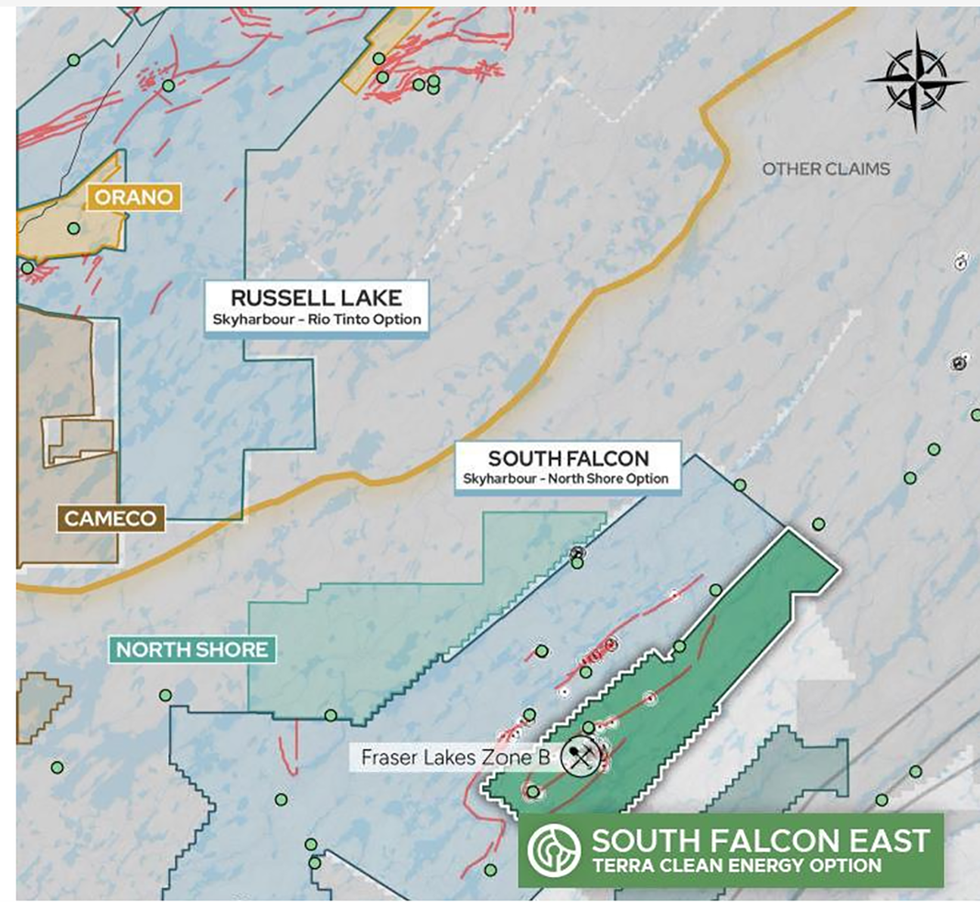
The mineralization is hosted in fractured and altered pegmatites and graphitic pelitic paragneiss, with the uranium accompanied by thorium and elevated concentrations of copper, nickel, vanadium, zinc, bismuth, molybdenum, lead and cobalt. Alteration assemblages include illite, dickite, kaolinite, chlorite, fluorite and hematite; these are classic markers of basement-hosted unconformity uranium systems. This setting, along with widespread clay alteration and structural disruption, mirrors some of the most prolific uranium systems in the basin, including Eagle Point, Millennium and Roughrider.
Fraser Lakes B sits on the central limb of the Way Lake Conductor, a folded EM corridor extending more than 25 km across the project area. This conductor hosts three major fold limbs (West, Central, and East), but only the central limb, where Fraser Lakes B is located, has been materially drilled. The deposit currently exhibits a strike length of approximately 1,400 meters, dipping northwest, and remains open in all directions. A north-northeast-trending fault, known as the T-Bone Lineament, intersects the deposit’s eastern margin, suggesting additional structural complexity and potential uranium conduits along strike.
Historic drilling from 2008 to 2015 by Skyharbour Resources and JNR Resources identified numerous mineralized intervals. Highlights include:
- 0.165 percent U₃O₈ over 2 m (within a broader 6 m grading 0.103 percent U₃O₈) in FP-15-05.
- 0.183 percent U₃O₈ over 1 m in WYL-50.
- 0.242 percent U₃O₈ over 0.5 m in WYL-61.
- 0.057 percent U₃O₈ over 5.5 m in the same hole.

These results demonstrate multiple stacked mineralized horizons over widths up to 65 m, open to depth and laterally.
In early 2024, Terra’s Phase 1 drill program confirmed the presence of uranium-bearing pegmatites in close proximity to historical intercepts. Hole SF-0059 intersected 13.5 m of mineralization, including 0.07 percent eU₃O₈ over 1.1 m, while SF-0060 returned intervals such as 0.02 percent eU₃O₈ over 1.3 m at 142.15 m. These intercepts confirm the extension of mineralization along strike and at depth from FP-15-05 and support the hypothesis of lateral continuity and stacked mineralized bodies.
Planning for an extensive summer 2025 drill program is underway, which consists of approximately 2,500 meters. The program will test areas identified during the winter 2024 program, where it is interpreted that a north-northwest trending brittle structure, a north dipping structure with strong clay alteration, and mineralized pegmatites with hydrothermal hematite alteration hosted in graphitic pelitic gneiss all intersect.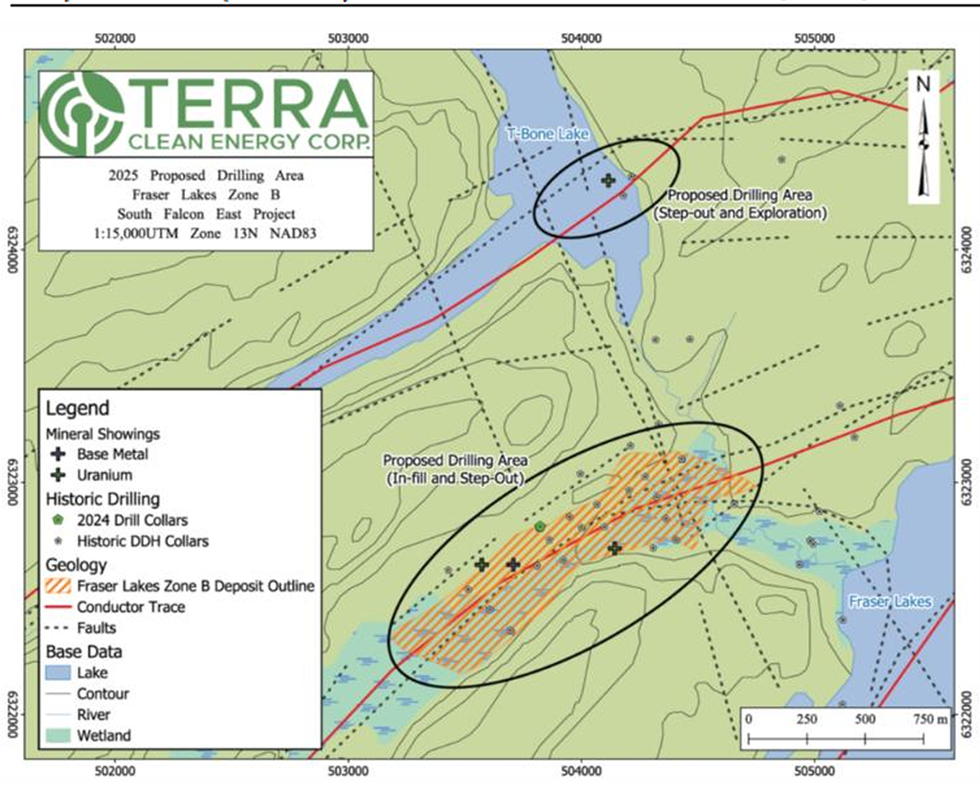
In addition to Fraser Lakes B, the company is evaluating regional targets such as T-Bone Lake, which has returned values up to 0.055 percent U₃O₈ over 0.9 m and features promising clay alteration and structural complexity similar to known high-grade deposits.
The overarching exploration thesis is that the Way Lake Conductor may host a clustered uranium system, with multiple deposits along its folded structure. Very little drilling has been conducted outside the current Fraser Lakes B footprint, giving Terra significant discovery potential across the entire 25 km strike length.
Management Team
Greg Cameron – President, CEO and Director
A seasoned capital markets professional, Greg Cameron has two decades of experience in business development, strategy and M&A. He is a former senior banker at Canaccord Genuity and Macquarie, and managing director at Colby Capital. He brings transactional and restructuring expertise critical to junior exploration growth.
C. Trevor Perkins – VP, Exploration
A professional geologist, C. Trevor Perkins has a track record in uranium exploration, including major results in the Athabasca Basin. He also serves as VP exploration for Azincourt Energy and has led exploration strategy and drill execution across multiple high-impact programs.
Alex Klenman – Director
Alex Klenman is a veteran junior mining executive with 30+ years’ experience, including uranium-specific roles. He is the CEO and director of Azincourt Energy, and has raised more than $18 million for Athabasca exploration. Klenman brings deep investor relations and financing expertise.
Tony Wonnacott – Director
Tony Wonnacott is a Toronto-based securities lawyer with more than 25 years of experience in capital markets. Instrumental in multiple successful listings and over $1 billion in financings and M&A transactions.
Brian Shin – CFO
Brian Shine is a chartered professional accountant with 15 years’ experience across roles in public companies. He specializes in reporting, risk management and corporate finance.
Jordan Trimble – Technical Advisor
Jordan Trimble is the CEO of Skyharbour Resources and a leading voice in the uranium investment community. He brings global capital markets insight and technical expertise, enhancing Terra’s industry reach and credibility.
Keep reading...Show less
16h
A$4.5M Placement to Underpin Resource Growth Strategy
26 June
John Ciampaglia: Uranium Turnaround? Spot Price Pop, Stocks and SPUT Raise
John Ciampaglia, CEO of Sprott Asset Management, discusses uranium supply, demand and pricing, also sharing details on the Sprott Physical Uranium Trust's (TSX:U.U,OTCQX:SRUUF) recently closed US$200 million bought-deal financing.
"It's clearly acted as a very positive catalyst — the spot price has popped, a lot of the equities have popped on this," he said about the agreement.
Don't forget to follow us @INN_Resource for real-time updates!
Securities Disclosure: I, Charlotte McLeod, hold no direct investment interest in any company mentioned in this article.
Keep reading...Show less
25 June
North Shore Announces Binding Term Sheet for Rio Puerco Uranium Project in New Mexico, USA
North Shore Uranium Ltd. (TSXV:NSU)("North Shore" or the "Company") is pleased to announce that on June 23, 2025, it signed a binding term sheet (the "Term Sheet") with Resurrection Mining LLC ("Resurrection"), an arm's length party, to acquire up to 87.5% of the Rio Puerco uranium project ("Rio Puerco" or the "Project") in northwestern New Mexico (the "Transaction").
TRANSACTION AND PROJECT HIGHLIGHTS
- Historical resource estimate of 6.0 million tonnes at an average grade of 0.09% eU 3 O 8 for 11.4 million lbs. of U 3 O 8 reported in 2009
- Substantial historical dataset to guide and optimize future exploration programs
- Preliminary review of historical data suggests the potential for In-Situ Recovery ("ISR") mining, the lowest cost method for producing uranium
- Located in the Grants Uranium District, the largest producer of uranium in the United States and near two significant active uranium projects, Marquez-Juan Tafoya (Anfield Energy Inc.) and Cebolleta (Premier American Uranium Inc.)
- Strong US government support for nuclear power and uranium mining projects and a stated objective to reduce reliance on foreign nuclear fuel
- Executive Orders issued by President Trump in late May 2025 include a call for quadrupling US nuclear capacity by 2050, accelerating new reactor development, strengthening the US nuclear fuel supply chain and reforming the US regulatory environment
- Staged earn-in structure allows the Company to optimize exploration programs
- Would provide North Shore with uranium exposure in two North American jurisdictions, the Athabasca Basin in Saskatchewan, Canada and the western USA
Brooke Clements, President and CEO of North Shore stated: "The Rio Puerco project in New Mexico offers us exposure to a uranium project in the USA with excellent upside and signficant historical exploration data including a historical resource estimate. The US government has recently enacted policies designed to accelerate nuclear power and uranium mining activity in the country. In the 1970s, Kerr-McGee commenced mine construction at Rio Puerco, but activity was halted after a short trial-mining phase due to low uranium prices. The Project offers a great opportunity to confirm and expand upon previous work through drilling, modern 3-D modelling and continued assessment of the ISR potential. On completion of the Transaction with Resurrection, we will have uranium exposure in two North American jurisdictions that have seen signficant uranium production, the Grants Uranium District and the Athabasca Basin, at a time when future supply-demand fundamentals look great for the industry."
Rio Puerco is located at the eastern end of the Grants Uranium District, approximately 60 kilometres northwest of Albuquerque, New Mexico (Figure 1). Mines that operated between 1950 and 2002 contributed to make the Grants Uranium District the leading historical uranium producing district in the United States.

Figure 1: Rio Puerco Location Map, New Mexico. Roca Honda (Energy Fuels), Marquez-Juan Tafoya (Anfield Energy) and Cebolleta (Premier American Uranium) are advanced exploration/development stage uranium projects.
RIO PUERCO PROJECT SUMMARY
Rio Puerco consists of 37 Bureau of Land Management mining claims and significant historic exploration and mining data as well as the rights to a water well. Historical exploration and development work by Kerr-McGee Corporation ( "Kerr McGee" ) in the 1960s and 1970s, and geologic and resource modelling work completed by two Australian companies in 2009 and 2011 validate the potential for Rio Puerco to host a significant uranium resource.
Uranium was first discovered at Rio Puerco in 1968. The claims covering the discovery were ultimately optioned to Kerr-McGee who drilled over 1,000 holes. Based on the results of that work, they began the development of the Rio Puerco Mine in the 1970s. The uranium mineralization is hosted in sandstone of the Jurassic-aged Morrison Formation, host to almost all of the significant uranium deposits in the Grants Uranium District. The mine was intended to be a room and pillar underground mine but was never put into production. Activity ceased after a short trial mining phase likely due to low uranium prices at the time. The underground mine infrastructure included a 260m vertical shaft, ventilation shafts, mining adits and support buildings. The mining shaft remains at the site and road access to the site is excellent.
In 2009, Monaro Mining NL ( "Monaro" ) commissioned an independent geological review and resource estimate for Rio Puerco using exploration data generated by Kerr-McGee in the 1960s and 1970s. The data used for the resource estimate consisted of historical maps and data from 764 drill holes including downhole gamma-ray data converted to percent equivalent U 3 O 8 (e U 3 O 8 ), geological logs and drillhole survey data. They reported a JORC 2004-compliant inferred resource of 6.0 million tonnes at an average grade of 0.09% eU 3 O 8 using a cutoff grade of 0.03% eU 3 O 8 for 11.4 million lbs. of contained U 3 O 8 1 (the " Historic Resource" ). JORC is the Australian Joint Ore Reserves Committee, a professional code of practice that sets minimum standards for public reporting of Mineral Resources.
In 2011, Australian-American Mining Corporation Ltd. commissioned a technical report on Rio Puerco. This most recent report validated and confirmed the Historic Resource 2 .
No significant exploration or development work has occurred at Rio Puerco since the 1970s.
HISTORICAL RESOURCE ESTIMATES FOR THE RIO PUERCO PROJECT
The historical resource outlined in this news release has not been verified and should not be relied upon. It is a historical estimate and not current and does not comply with Canadian NI 43-101 guidelines for the reporting of Mineral Resources. A qualified person has not verified the historical resource on behalf of the Company and North Shore has completed no work programs at Rio Puerco. Though not current, the Company views the historical resource estimates as reliable and sufficient to justify the initiation of work programs aimed at validating and potentially expanding upon the estimates. There is no guarantee that the work programs envisioned by North Shore will ultimately result in the definition of NI 43-101 compliant resources.
RIO PUERCO TERM SHEET
Completion of the Transaction is contingent on North Shore completing satisfactory due diligence, execution of a definitive agreement, completion of a minimum $750,000 financing by North Shore and approval by the TSX Venture Exchange (the "Exchange" ). A finder's fee may be payable to an arms-length third party upon completion of the Transaction. The following highlights key terms of the Term Sheet executed by North Shore and Resurrection, all currency references are in Canadian dollars:
- Milestone 1: upon completion of the Transaction, a $125,000 cash payment and issuance of 9.99% of the issued and outstanding shares of the Company, post-financing.
- Milestone 2, to earn a 40% interest in the Project: on or before 18 months after completion of the Transaction, a $250,000 payment in cash or common shares, at the option of North Shore, and $750,000 in exploration expenditures.
- Milestone 3, to earn an aggregate 65% interest in the Project: on or before 36 months after completion of the Transaction, a $375,000 payment in cash or common shares, at the option of North Shore, and $1,000,000 in additional exploration expenditures.
- Milestone 4, to earn an aggregate 87.5% interest in the Project: on or before 60 months after completion of the Transaction, a $500,000 payment in cash or shares, at the option of North Shore, and $1,500,000 in additional exploration expenditures.
- North Shore may elect to not continue to sole-fund exploration expenditures at any time after earning a 40% interest in Rio Puerco at which time North Shore and Resurrection will enter into a joint venture agreement to govern the funding of Rio Puerco on a proportional basis.
- Carried interest: On completion of Milestone 4, North Shore will provide Resurrection with a 12.5% free-carried interest in the Project through completion of an NI 43-101-compliant Preliminary Economic Assessment at which time Resurrection can elect to form a participating joint venture or convert their interest into a 1.0% net smelter returns royalty. North Shore will be granted a right of first refusal on Resurrection's 12.5% interest.
- Bonus payments: For the 78 month period after completion of the Transaction, North Shore will pay Resurrection a $100,000 bonus for each million lbs. of uranium estimated in current resources defined by the Company above 5 million and up to 20 million lbs. in accordance with NI 43-101 standards, if and when such resources are defined.
- Other terms: Resurrection shall have a participation right to maintain its 9.99% interest in the common shares of North Shore for 5 years from completion of the Transaction and the right, but not the obligation, to appoint one nominee to the North Shore Board of Directors. All share issuances will be subject to Canadian and US securities law and will be priced in accordance with Exchange policies.
NEXT STEPS
After completion of the Transaction, North Shore will begin working towards defining the first NI 43-101-compliant uranium resource at Rio Puerco. The Company's initial work will aim to verify historical data and determine whether a resource can be defined in accordance with NI 43-101. First, geologic models of the previously defined deposit will be prepared using drill hole summary logs containing the interpreted zones of uranium mineralization. A number of confirmation drill holes are required to confirm the historic uranium grade and uranium disequilibrium, and for metallurgical testing. For the first program, 20 to 40 holes are contemplated, a combination of diamond core holes and rotary holes where a downhole gamma ray probe is used to determine uranium content. After the results of that program are received and interpreted, a comprehensive drilling plan would be developed aimed at defining a resource. Data from the drill programs will be used to further evaluate the amenability of ISR mining.
ABOUT NORTH SHORE
The nuclear power industry is in growth mode as more nuclear power will be required to meet the world's ambitious CO 2 emission-reduction goals and the needs of new power-intensive technologies like AI. In this environment, new discoveries of economic uranium deposits will be very valuable, especially in established uranium-producing jurisdictions like Saskatchewan and New Mexico. North Shore is well-positioned to become a major force in exploration for economic uranium deposits. The Company is working to achieve this goal by exploring its Falcon and West Bear properties at the eastern margin of the Athabasca Basin in Saskatchewan, expanding its exploration efforts to include the Grants Uranium District in New Mexico and by evaluating other quality opportunities in the United States and Canada to complement its portfolio of uranium properties. North Shore summarized its exploration efforts at its Falcon property in a May 27, 2025 , news release.
QUALIFIED PERSON
Mr. Brooke Clements, MSc, P.Geol., a Qualified Person as defined by National Instrument 43-101 - Standards of Disclosure for Mineral Projects and the President and CEO of North Shore, has reviewed and approved the scientific and technical disclosure in this press release.
ON BEHALF OF THE BOARD
Brooke Clements,
President, Chief Executive Officer and Director
For further information:
Please contact: Brooke Clements, President, Chief Executive Officer and Director
Telephone: 604.536.2711
Email: b.clements@northshoreuranium.com
www.northshoreuranium.com
Neither the TSX Venture Exchange nor its Regulation Services Provider (as that term is defined in the policies of the TSX Venture Exchange) accepts responsibility for the adequacy or accuracy of this release.
Forward-Looking Statements
This news release contains forward-looking statements that are based on the Company's current expectations and estimates. Forward-looking statements are frequently characterized by words such as "plan", "project", "appear", "interpret", "coincident", "potential", "confirm", "suggest", "evaluate", "encourage", "likely", "anomaly", "continuous" and variations of these words as well as other similar words or statements that certain events or conditions "could", "may", "should", "would" or "will" occur. Such forward-looking statements involve known and unknown risks, uncertainties and other factors that could cause actual events or results to differ materially from estimated or anticipated events or results implied or expressed in such forward-looking statements. Such factors include, among others: the completion and expected terms of the Transaction, the parties' abilities to meet the closing conditions of the Transaction, the number of securities to be issued by the Company in connection with the Transaction, receipt of all necessary approvals for the completion of the Transaction, the completion of satisfactory due diligence, execution of a definitive agreement, completion of a minimum $750,000 or any financing by the Company, and the Company's ability to meet the Milestones, make the bonus payments or meet other terms of the Transaction; the highly speculative nature of the Transaction given the early-stage nature of Rio Puerco; the actual results of current and planned exploration activities including the potential for the definition of a mineral deposit of potential economic value at the Company's Falcon property in Saskatchewan; that drilling results, geophysical survey results and/or interpretations thereof are defining potentially mineralized corridors; results from future exploration programs including drilling; interpretation and meaning of completed and future geophysical surveys; conclusions of future economic evaluations; changes in project parameters as plans to continue to be refined; possible variations in grades of mineralization and/or future actual recovery rates; accidents, labour disputes and other risks of the mining industry; the availability of sufficient funding on terms acceptable to the Company to complete the planned work programs; delays in obtaining governmental approvals or financing; and fluctuations in metal prices. There may be other factors that cause actions, events or results not to be as anticipated, estimated, or intended. Any forward-looking statement speaks only as of the date on which it is made and, except as may be required by applicable securities laws, the Company disclaims any intent or obligation to update any forward-looking statement, whether as a result of new information, future events, or results or otherwise. Forward-looking statements are not guarantees of future performance and accordingly undue reliance should not be put on such statements due to the inherent uncertainty therein. Any forward-looking statements contained in this news release are expressly qualified in their entirety by this cautionary statement.
1 Monaro Mining NL, 2009, 250% increase in uranium resource inventory at Rio Puerco deposit, New Mexico USA: Monaro Mining NL ASX news release: (link)
2 Boyer, D. and Ostensoe, E., 2011, NI 43-101 technical report, Rio Puerco deposit, Sandoval county, New Mexico, USA: Independent report commissioned by Australian-American Mining Corporation Ltd.: (link)
Keep reading...Show less
Latest News

Sign up to get your FREE
Toro Energy Investor Kit
and hear about exciting investment opportunities.
- Corporate info
- Insights
- Growth strategies
- Upcoming projects
GET YOUR FREE INVESTOR KIT
Latest Press Releases
Related News
TOP STOCKS
American Battery4.030.24
Aion Therapeutic0.10-0.01
Cybin Corp2.140.00




